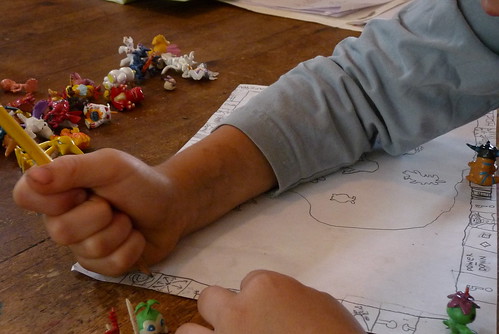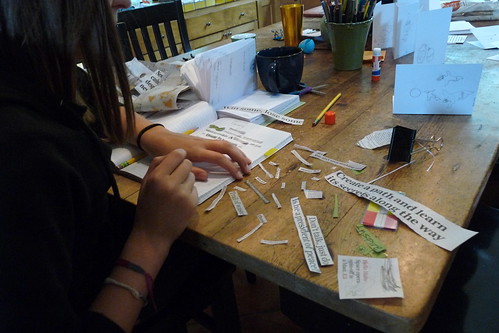For years I’ve struggled with the term unschooling. It’s such a great word, implying a complete departure from school. To me, it conveys a sense of kids leading their own educations, which is something we value around here. But it’s also come to imply, it seems, a certain lack of structure, and that’s the part that keeps me from embracing it. I’ve never felt that we could call ourselves unschoolers because we have a definite structure to our days. Or at least part of our days.
Structure. Now there’s another loaded word. Structure seems reinforced with negative connotations: rigidness, confinement, predictability.
I realize that I’ve written about this before. But it’s something that I think about often. And the more new homeschoolers I meet, the more I notice that many people still believe that there are two basic camps of homeschooling: unschooling and school-at-home. Sometimes new folks don’t realize that there’s a stunning variety of shades across that spectrum.

I know I’ve said this before too, but here’s a nutshell history: when we started homeschooling, we were fairly schoolish. It had only been a few years since I’d been a classroom teacher myself, and that was what I knew. Granted, I was a pretty creative teacher, and I had lots of neat projects in mind! But my oldest child quickly cured me of All My Good Ideas. “I don’t want to do that art project,” he’d say, or “I don’t want to read that book.” He asked questions like, “Why should I write down my thinking on that math problem when I can just tell you? You’re sitting right next to me!”
Good points. He was right. When I let him do projects that interested him, he was immersed. When I forced him to do work he didn’t want to do, he was angry and frustrated and didn’t learn much. I learned to stop doing that. (Well, I slowly learned to stop doing that. Sometimes I’m still learning.)
I got better and better at dropping the schoolish thinking that had me teaching him, and planning lessons for him. But we kept the habit of working together for a few hours most morning. We had fun reading together, making things together. Knowing we had a few open hours meant we could take on big projects, make big messes. Plus, it was the one time of day that the kids knew they had my full attention, that I wasn’t going to get lost on the computer, or start talking on the phone. Still, the fact that we did it every day, at a particular time, made it a structured activity. With all those negative connotations.

I finally came to terms with our homeschooling style a few years back when I read The Creative Habit, by choreographer Twyla Tharp. I read the book for help with my writing practice; only later did I realize its implications in our homeschooling life.
Tharp writes:
“There’s a paradox in the notion that creativity should be a habit. We think of creativity as a way of keeping everything fresh and new, while habit implies routine and repetition. That paradox intrigues me because it occupies the place where creativity and skill rub up against each other.”
And:
“I will keep stressing the point about creativity being augmented by routine and habit. Get used to it. In these pages a philosophical tug of war will periodically rear its head. It is the perennial debate, born in the Romantic era, between the beliefs that all creative acts are born of (a) some transcendent, inexplicable Dionysian act of inspiration, a kiss from God on your brow that allows you to give the world The Magic Flute, or (b) hard work.
If it isn’t obvious already, I come down on the side of hard work. That’s why this book is called The Creative Habit. Creativity is a habit, and the best creativity is a result of good work habits. That’s it in a nutshell.”
Reading her book convinced me of what I’d already sensed: that scheduled practice doesn’t have to undermine creativity; rather, it can help it to thrive. I could see this with my writing. I don’t have the freedom at this point in my life to write whenever the muse strikes; instead I have to plan time for it. And I’ve done it for long enough now that my creative mind is conditioned to get right into the work, pretty quickly after I sit at my desk. I only have so much time, and I don’t want to waste it.

I think it’s the same for my kids. Gathering in the kitchen at 9:30 or 10:00 each morning for tea and a snack is their cue to start thinking, start bouncing ideas from their heads to the ceiling to the yellow counters and back again. I’ll often throw out a few suggestions, depending on what they’re working on, but more often than not, they have their own ideas. Today Lulu wanted some ideas for writing and I pulled out our copy of the utterly fabulous Don’t Forget to Write for her. Something there gave her the idea to make found phrases poems from the newspaper. Mr. T wanted to do more work on the game he’s designing. Would they have done these activities later in the day, on their own? Maybe. They do lots of interesting projects on their own, in the afternoon, in the evening, whenever. But this morning, Mr. T needed my help to write his game rules, and Lulu wanted help brainstorming a project. And I was there to help them. Then they were on their way.

Sometimes I call what we do structured unschooling because the phrase is so laughably oxymoronic. But I think I’ll just strike the word structure from my vocabulary and use habit instead. A homeschooling habit. That’s what we have most mornings around here–complete with tea and snacks.
(You can leave comments–and read some wonderfully insightful ones–on the original 2009 post: the homeschooling habit.)
